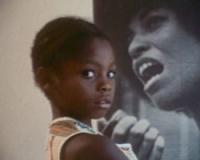In an early scene in Julie Dash’s Illusions (1983), which takes place in Hollywood in 1942, Mignon Duprée, an executive assistant, reads a telegram received by National Studios announcing the American military’s use of “Navahoe” (Navajo) code talkers for their communications during World War II; this code would become recognized historically as one of the few “unbreakable” code used by the American military during WWII. From this very early scene the film, the use of codes for strategic advantage emerges as a key theme in the film.
In a later scene, Mignon and Esther, a Black singer brought to the studio to surreptitiously dub the voice of a white star, sit on a settee in a production office in conversation under the scrutiny of a white secretary who does not grasp what Ester recognizes: that Mignon is Black. The situation is ironic: they discuss their positions as Black women in the entertainment industry, while the secretary does not see beyond Mignon’s light skin to recognize that both Mignon and Ester are speaking as Black women, and not a white woman speaking to a Black woman. Mignon nervously looks over her shoulder throughout their conversation, but no one seems to overhear enough to understand what is being said: her light skin, her authority in the studio, makes such recognition impossible to a white mainstream, where power is always coded as “white.” The actual content of their conversation therefore goes unrecognized, concealed by the code of racial optics.
Mignon has skillfully manipulated racial codes to maneuver herself behind “enemy lines”: she has passed as white and worked to a position of remarkable authority in Hollywood in order to bend the system to the advantage of other Black people working in the entertainment industry. In so doing, she has opened a space for Black people and other minorities in hostile territory. This space might go unnoticed by white authorities, but here she and others can have meaningful social exchange that cements their solidarity, a form of historical agency through which they work together to subversively introduce alterations to the studio system. There are no giant, revolutionary strides made here: Mignon negotiates fair compensation for Esther for her voice work, and peppers her boss with ideas for films about Navajo code-talkers and Black American military personnel. These changes and pressures are subtle but extraordinarily profound: they encourage an attitudinal shift that changes the terms in which the studio engages with Black people and other minorities to bring about greater social and economic equity and democratic participation in the system – values that, the film points out, the US entered World War II to fight for in the first place.

The idea of “passing,” foregrounded in this film in terms of race, is of course also a central aspect of the queer experience in a variety of ways. A closeted queer person may endeavor to pass as straight if she feels unsafe or unready to be perceived as queer; an out person may choose to pass in able in certain situations to avoid unwanted discussion on the topic; a queer person may even pass without meaning to, if his gender expression causes others to assume he is straight. The concept of passing is even more complicated for transgender and genderqueer people, as the way their gender identities are perceived may be even more in flux, whether they intend to pass or not.
The activity of passing by queer people is relevant to consider with this film because of a quick yet striking line of dialogue near the beginning of the film. When Mignon is speaking with the sound engineers preparing to record Esther’s musical performance, the younger of the engineers comments on how much he enjoyed watching the male dancers and singers, especially the “colored” ones, that had appeared in some of the studio’s films. Mignon turns and quips, “I guess we know why you didn’t get drafted,” referring to the ban on homosexuals in the army first widely enforced during World War II. The young man looks uncomfortable and stops talking.
Her comment draws attention to the structure of the “closet” so present in this film. This term is usually used to a metaphorical space where a queer person hides that aspect of identity, but this film gestures towards parallel structures of the closet: as the sound engineer presumably occupies a closet (though rather transparently in this case) as a gay man, Mignon is occupying a closet as a Black woman. Both have characteristics that if “seen” will exclude them from full personhood in dominant society, so there is incentive to hide or simply not advertise these traits. This “masking,” as Julie Dash describes it, has even deeper resonances in the film with Esther’s voice coming through the lips of white actress Lila Grant onscreen – Esther can only find a place on theater screens by wearing the mask of Lila, while Mignon can navigate her studio environment by wearing the mask of a White woman (or, more specifically, simply not informing her white coworkers that they are reading her incorrectly – their unconsidered assumptions about her race function as her mask). The closet, or the mask, is unquestionably an uncomfortable space to inhabit; however, Mignon’s closing speech, a rousing call to action, explains exactly what social change she hopes to achieve while she does inhabit that space.
—Karrmen Crey and Bryan Wuest






 Mobile Navigation
Mobile Navigation

